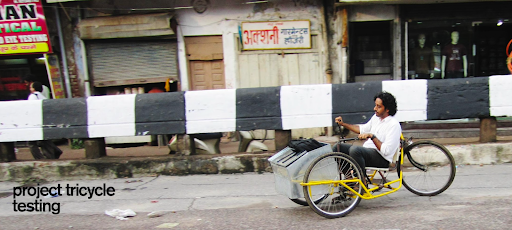Som Ray - CEO, CLIPBIKE
Som Ray is a Design Technologist & award-winning mobility designer from MIT with deep expertise in Product and Industrial design. He is also the founder and CEO of ClipBike, a company that is disrupting the mobility industry by providing a sustainable, eco-friendly, and cost effective option to most electric bikes available today. He spoke to me over Zoom from his office in Brooklyn.
What sparked the idea for CLIPBike?
I got into mobility after I joined the Smart Cities group in the MIT Media Lab. In that lab, there is an entirely new paradigm of looking at vehicles and mobility. After the MIT Media Lab I decided to go back home to India to try to address the huge air pollution issue by trying to create a fully electric auto rickshaw. Sadly it did not pan out because the battery tech was not quite there at the time. When I started working in New York again I decided to take up cycling as my main choice of mobility and I noticed that getting to work in the morning was an issue because I did not want to arrive at work out of breath and sweaty and I also soon realized that even committed bikers like me could use the occasional pedal assist of an e-bike, speeding up my commute time to work and reducing stress. So I decided to research electric bikes and I immediately identified a couple of problems: Electric bikes are big, bulky and are hard to store. They get stolen often because of their valuable parts and batteries and they also take the diversity and expression out of our beloved regular old bicycles. So what if I could just take the “e” out of an e-bike and carry it into the office with me?
How is CLIPBike different from regular e-bikes?
As I mentioned, regular E-bikes have a host of problems: They are big, expensive and get stolen very often, and take the expression out of our beloved regular old bikes. We designed CLIP to be a cheaper, portable source of power for your regular bike. (Here is a chart that represents this as well as a video on how to install)
What was the process for designing CLIPBike?
I designed and built the alpha prototype as a proof of concept and then I hired a mechanical engineer, an electrical engineer, and a firmware designer to help me develop the project further. I currently have version one of CLIP and I am working on version two for the United States and Europe. I am also working on versions that are specifically for developing countries and economies like India and Africa where normal people can't afford to buy something for $400 but would still greatly benefit from it.
What was your journey that led you to CLIPBike?
Chandigarh, where I grew up is a city designed by the renowned French architect Le Corbusier so naturally I was surrounded with incredible art and architecture throughout my childhood. I began studying architecture in the Delhi Sushant School of Architecture. But in India there is not a lot of expression relative to the work you did in school, especially with architecture. You want to do all of these interesting, forward thinking projects, but you are stuck doing something extremely limiting instead.
At this point I decided to move to New York and continue my architecture studies at Columbia University. At Colombia, we did so many incredible projects which had little to do with reality and we would theorize about the future of architectural expression and building organization which would eventually support future societies.
At my first job after Columbia, one of my mentors was Mitch Ruskin. He was a futurist who had worked in the Smart Cities Lab in the Media Lab at MIT. One of the focusses of the Lab was designing cars, particularly in the City Car project which considered how to reduce greenhouse gas emissions and urban congestion which cars produce. We even theorized about folding and stackable cars. Mitch introduced me to my next mentor and advisor Bill Mitchell, who ran this group at the Media Lab. One cold winter morning I met him in his office at the Media Lab and I showed him my work and what I wanted to do and at this point I didn’t have any kind of financial support at all, so I had no idea how I could study at MIT. Bill essentially said, “Don’t worry about it, we got you”. He figured out the entire scholarship situation which enabled me to work in this incredible Lab at MIT. That was the trajectory.
What has been the hardest part about launching ClipBike?
I used to love innovating where you are constantly building new ways to engage with the world. But now I am in a place where I understand that with art and innovation there are short time frames involved and it's easy to do that kind of reinvention when it is necessary. But when you are developing a product and a company you need to keep working on it for six or seven years to really become successful. My focus now is realizing the innovation that we have created at CLIP and how we get it out to millions of people. It's a different mindset and it is not as quick as coming up with an idea and building a prototype. One of the hardest parts of production has been manufacturing though the pandemic. It is difficult to find components with supply chains blocked, but hopefully we are almost over that.
Is there a larger goal or purpose to CLIP bike?
Yes, like I briefly mentioned I’m working on sub innovations within the overall framework of the Company. So at Clipbike we have asked ourselves: If the larger framework is about building a company that can provide affordable electric mobility to the world, then what does that look like? We realized that: To be able to provide affordable electric propulsion to all different modes of vehicles will make a huge difference in the way that people move around in cities. If you can get more people to move around in such vehicles where the carbon footprint is almost minimal to zero, then you are beginning to create a larger impact, not just in terms of the quality of life in cities, but globally in the context of climate change.
What have been some of the highs and lows for you with CLIPBike?
When my customers write to you and say: “Hey, I love this device, I've been using it every day and it has really changed my life” Seeing the impact of the work that we have been doing has been a really big thing for me. On the flipside, there are moments when you put in a lot of effort and then one tiny thing that you overlooked or you didn't even know to look for leads to failure.
What is important for teenagers to set them up for success in life?
It's tricky to know when you're young how life is going to be. You’re super confident and you feel like you know everything. You kind of get influenced quite easily as well. Having great mentors is really important when you’re at that age to guide you and help you.
Who was someone you looked up to as a child?
When I was a child I looked up to Ayrton Senna. He was a fantastic Formula One driver. And I remember the day that he passed away. The thing I really admired about him was that he had this singular focus and it was so intense that it elevated him to a level of spirituality. I think in one of his interviews, he talks about how he's driving his Formula One car in Monaco and he sets one of the fastest records. And he talks about his soul rising from his body and watching him drive the car from above. I always felt he was a superhuman being.
What inspires you?
When your project provides joy to lots of people I think that really inspires you. We just shipped out the first units of the CLIP and yesterday this couple in Arizona sent me photos of the CLIP on their tricycle. That's the kind of stuff which is inspiring because you feel you're creating an impact and that if you work harder, then you could make a serious difference. That’s what success looks like to me.
Go check out ClipBike!


